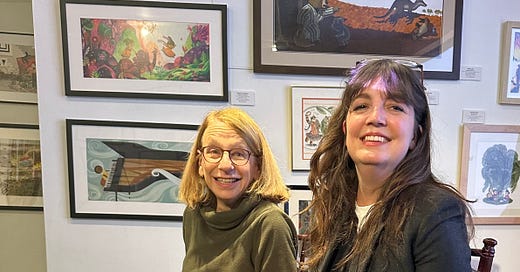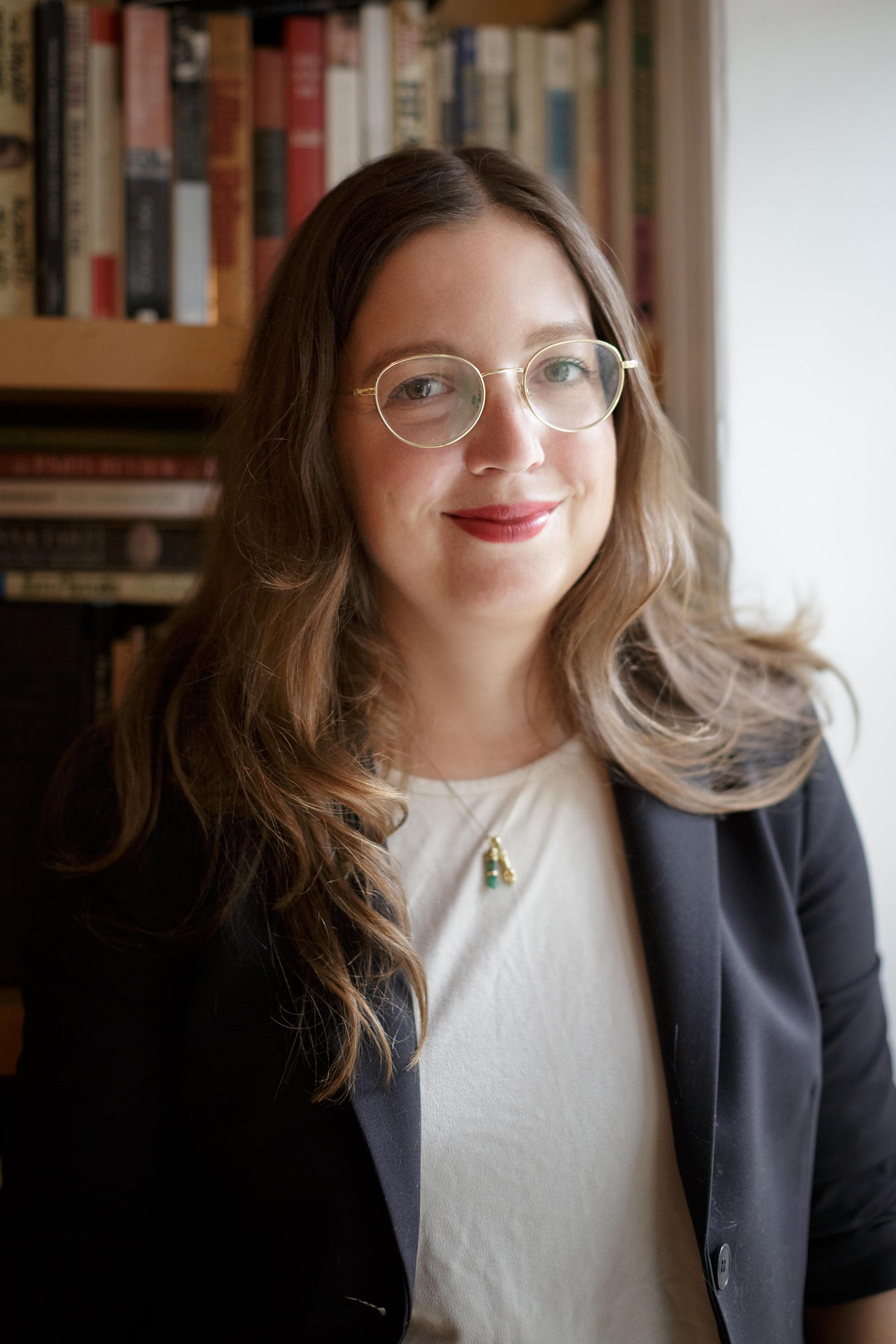
Tomorrow, I will be interviewing The New Yorker’s Cartoon Editor, Emma Allen for our documentary Women Laughing. Emma has been my editor now for almost six years, and she was the first woman at the magazine to hold that job. She and I will sit and talk about her groundbreaking role, and how it inspired an increase in diversity among cartoonists, not only just by her being in that role, but because of her concerted efforts to bring on more people of color, women and trans artists. I also plan to talk with her about the history of women cartoonists at the publication. And I will live-draw her——never done that before!
Emma is herself very funny, generous and thoughtful—all things you want in an editor. I look forward to talking with her again!
Below is the foreword that she and Senior Editor David Remnick graciously wrote for my 2022 book, Very Funny Ladies: The New Yorker’s Women Cartoonists. I hope you enjoy reading it.
David Remnick: Emma, Liza has done a lot to shine a light on the women who have published cartoons in The New Yorker. She’s been rightly critical of how long it took before more than just a few women were drawing for the magazine at any one time, but she’s also told the story from the very start.
Emma Allen: A thing that I don’t think a lot of people know is that there was a cartoon by a woman in the very first issue of The New Yorker, which, despite all the dead-serious stuff we now publish about issues of war and peace, was in fact launched as a “comic weekly,” in 1925. I remember being so excited when I learned that, but then I looked up the cartoon and could not understand it in the slightest. Something about flappers and “the wages of sin”—they apparently don’t get enough of wages, and/or sin? But then I came across this book and found myself cracking up at a Barbara Shermund cartoon from 1928, in which a man blathers on for eight panels to his totally silent date, and then, in panel nine, states, “You’re a very intelligent little woman, my dear.” Because it’s a mansplaining joke! We’d run it today, right? Ditto the classic, caustic Alice Harvey gag, also from the late twenties, in which one woman confides to another, “Oh she’s very attractive I don’t like her at all.” It’s essentially the same joke as one of my favorites from Nora Ephron’s “When Harry Met Sally,” when Carrie Fisher’s character describes Harry’s new girlfriend to Sally: “Thin. Pretty. Big tits. Your basic nightmare.”
DR: I see the link!
EA: And of course there have been droves of amazing women cartoonists who have contributed since 1925, including Liza. Though there were some stretches in which the gender equity and diversity among the cartoonist pool was pretty abysmal. I often think about Roz Chast’s story about how, when she first sold a cartoon, in 1978, a male cartoonist asked then-cartoon-editor, Lee Lorenz, if Lee owed Roz’s family money. I won’t ask if you got any similar remarks, regarding my hiring.
DR: I have to admit one of the unexpected parts of starting this job was that the editor plays a serious role in choosing the cartoons. You deal with the artists directly, they all sub “roughs” to you––multiple roughs each, every Tuesday––and then you narrow those down to a pile of about fifty or sixty, and then we meet every Wednesday. I was really hoping that you’d bring more women, more artists of color, more younger artists into the mix at a faster rate. We talked about it right from the start and you were on it right away.
EA: People do often ask me, almost as an accusation, if I was hired to enlist more women cartoonists, like some sort of Soviet spy recruiter. And I assume to some degree it’s, like, yeah, absolutely. The thing is, though, that seeking out and publishing diverse new talents is not part of some secret agenda. As I see it, this magazine’s aim is to publish the best, most innovative voices in various artistic, journalistic, and literary fields. And it’s abundantly clear that doing so entails working with a diverse array of voices and perspectives, ones that allow many readers to see themselves and their experiences in the work we publish, not just Upper East Side dentists (who love our cartoons; just try being me and getting out of a dental cleaning in under an hour). As I see it, at the end of the day, lots of cartoons about old white men in boardrooms and operating rooms are boring.
DR: Some people can’t get that ridiculous Christopher Hitchens essay about women not being funny out of their heads. Ever since its publication, it seems, every funny woman—from Roz Chast to Tina Fey to Tiffany Haddish––has to answer to it in one way or another.
EA: I’ve definitely also had people imply that, as a woman, I might not be capable of picking cartoons that men find funny. In fact, a male cartoonist once said that to my face, immediately after I’d rejected a bad cartoon of his. But, David, you occasionally laugh at the cartoons I show you, in our weekly meetings, even when they’re about contentious things like how men are not always perfect. What is it, in your opinion, that makes a cartoon worth buying, since you have the final say? How do you know it when you see it? Correct me if I’m wrong, but I suspect your Y chromosome plays a minimal role.
DR: I’d guess that a lot of things play a role in what makes any one person laugh or not. Being a man is one, maybe, but as many things that comprise a human being go into your responsiveness to any art form, including the funny stuff. These things are so mysterious. I’ve been around the magazine for a long time and it seems to me that older readers, when they are in a mood sometimes, say the same thing with every passing generation: the cartoons used to be funnier. I have to think that’s been going on forever. And you do see things changing and it’s possible that some people are not eager to hear new voices, new jokes. Some of the old tropes––desert islands, two mopes at a bar, first dates, the climber seeking a shaman at the top of the mountain, there are lots of them––have been around for so long that the only time they work is when they have an added, modern twist, or some sort of self-deflating mechanism. What’s really refreshing and what enlivens the form is when someone comes along who has a distinct artistry, a look, and, maybe more important, a distinct world, a point of view. Roz Chast is a perfect example of that and maybe what is so amazing about her is that her world and her language is so rich that it keeps suggesting new possibilities, she keeps expanding her imagination and we’re laughing harder than ever. Very few artists in any field have that kind of distinctiveness and an ability to continue
EA: I think with certain New Yorker’s readers, it sometimes comes down to an aggrieved sense that it’s sacrilegious to change anything about the magazine. But publications, institutions obviously have to evolve to not feel fusty and dated, safe and stale. In the early days, a lot of the cartoons we ran were “he-said, she-said” jokes, with two stacked captions—a mini, witty repartee, rather than a single gag line—which was much less comedically elegant, in my opinion. When people bemoan that the cartoons aren’t as good as when they were young, I like to point out that while “Saturday Night Live” is forty-six years old, The New Yorker is ninety-six. But I guess people feel the same way about the SNL cast they grew up with. Doesn’t mean we or Lorne Michaels stop hiring new people, though.
DR: One of things that you have managed to do in a pretty short period of time is bring in more and more young artists––including, very much so, more women, more people of color––and, at the same time, you are paying a lot of attention to the work of people who have been around for a long time.
EA: I remember when someone pointed out, three or so years ago, that an issue of the magazine was the first ever in which there were more women cartoonist contributors than men cartoonist contributors. Which is nuts. And thank goodness has been repeated many times since. But it made me think of a story I probably learned from this book, about the cartoonist Hilda Terry saying in 1949 that the National Cartoonists Society should be renamed the National Men’s Cartoonists Society, since they didn’t admit women (apparently because then they feared they’d have to stop swearing in meetings). And still today, I think a lot of boys clubs are threatened by the idea of women in their midst and, in the world of comedy, justify it by saying that women won’t “get” or like their sense of humor. I mean, I grew up on Beavis and Butthead, and Jackass, and Judd Apatow’s bromances, and (to varying degrees) I loved them all. Even more, I love that there’s such a rich array of alternatives now. And I feel like being able to post jokes and cartoons and funny videos online, without having to make it past traditional gatekeepers, has really shifted the demographics of who can succeed, and who is succeeding.
DR: I used to worry that cartooning was like the craft of making horseshoes, that there were still wonderful craftsmen around, but they were aging and were not going to be replaced. But more and more, I see funny people, writers and artists, sending us cartoons. It seems like revival itself, and really promising.
EA: And yet, I will probably get submissions till I’m old and decrepit that are addressed “Dear Sir,” or worse, “Dear Sirs,” which brings to mind some powdered-wigged tribunal and seems also to imply that I’m not man enough, even Sir that I am, to do the job alone.
DR: Maybe I’m overly optimistic, Emma, but I bet that dwindles to nothing with time.
EA: And yet every year, like clockwork, the question, “Are women funny?” seems to be up for heated debate once again, incited by some stupid Op-Ed. But the joke’s on men, because, as this book proves, ladies are and have always been funny, and if you address me as “Sir” or “Sirs” you are very unlikely to be published.
DR: I’ve got your back on that!
Above is a drawing Emma bought from me a few eyars ago that I really like.
Thanks for being here, see you tomorrow—I’ll post my drawing of Emma and some photos from the shoot.







Wow ! That final drawing! 😂Laughed out loud and woke up
my old dog Pup sleeping on the sofa across the room from me!
Can I get a framed copy ?
I used to be a pop culture journalist. I know about male editors. This is the end you talk to.